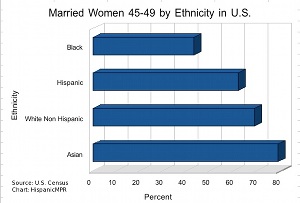Empty nests typical of mainstream while Latino family size steady
Posted by Elena del Valle on March 4, 2009
Married Women 45-49 by Ethnicity in U.S. 2008 – click on image to enlarge
Although mainstream families are showing a decline in fertility rates and as Baby Boomers age there tend to be fewer families with children 18 and under living at home, the situation is different among Latino families. In the general population the percentage of families with one or more children living at home decreased to 46 percent in 2008, from 52 percent in 1950 and 57 percent in the early 1960s, according to new data from the U.S. Census Bureau. On the other hand, 25 percent of babies and children five and under are Latino.
“Decreases in the percentage of families with their own child under 18 at home reflect the aging of the population and changing fertility patterns,” said Rose Kreider, family demographer at the U.S. Census Bureau. “In 2008, not only were Baby Boomers old enough that most of their children were 18 and over, but they were having fewer kids than their parents, as well.”
In 2008, 66.9 million opposite-sex couples lived together. Of those 60.1million were married, and 6.8 million were unmarried. At the same time, the percentage of adults ages 45 to 49 who were married varied by race and ethnicity. Among women 45 to 49, 79 percent of Asians, 69 percent of white non-Hispanics, 62 percent of Hispanics and 43 percent of blacks were married.
The census data suggests there are 25,173,000 married couples living with children or one million less than the previous year. That is the lowest number since 1999. Just over half of men and women over 18 are married and living with their spouse. People making $100,000 or more are more likely to live with their spouse, 82 percent of men and 65 percent of women.
The percentage of children living with two parents varied by race and ethnicity. Eighty-five percent of Asian children lived with two parents, while 78 percent of white non-Hispanic children, 70 percent of Hispanic children and 38 percent of black children cohabited with both parents.
Some 9 percent of all children (6.6 million) lived in a household where there was a grandparent; although for 23 percent of children living with a grandparent there was no parent in the household. In 2008, 6 percent of white non-Hispanic children lived in a household with a grandparent present, compared with 10 percent of Hispanic children, and 14 percent of both Asian and black children.
The findings come from America’s Families and Living Arrangements: 2008, a collection of 2008 Current Population Survey (CPS) statistics on family and nonfamily households, characteristics of single-parent families, living arrangements of children and data on married and unmarried couples released last week. The CPS has been conducted annually since 1940. This survey was conducted in February, March and April for a nationwide sample of 100,000 addresses.
Discover from a new mom market expert how to reach Latino moms by listening to
“Marketing to New Hispanic Moms – a case study” audio recording

Presenter Cynthia Nelson, COO, Todobebe
Find out about
• New Latina mom market
• Baby demographics including market size, profile
• New moms’ language preferences
• Latino baby market trends
• Factors influencing Hispanic baby market
• Location of new Hispanic moms’ market
• Issues affecting new Latino moms
• Todobebe strategies
Click for information on “Marketing to New Hispanic Moms – a case study”










